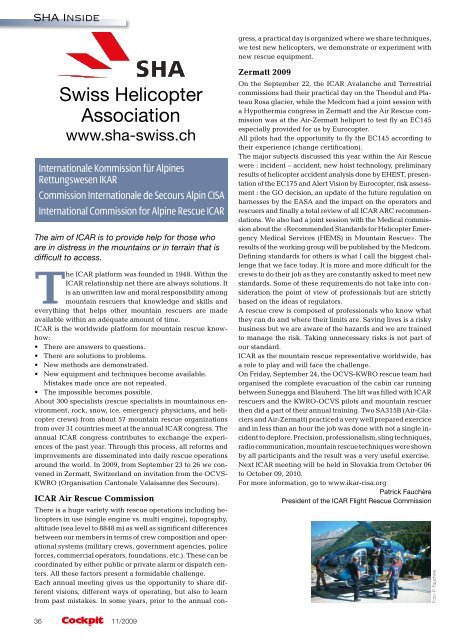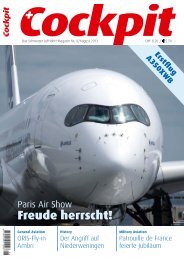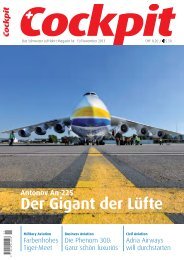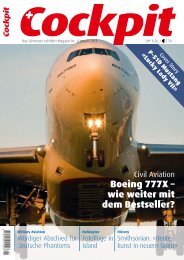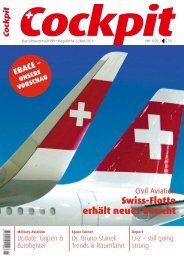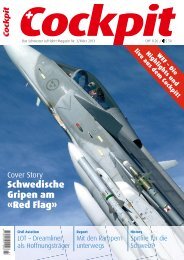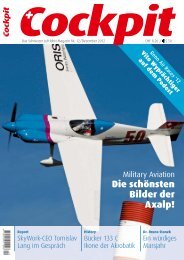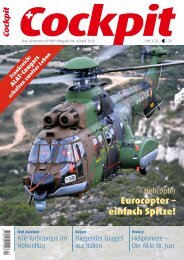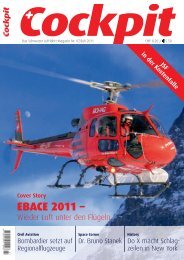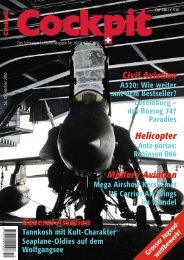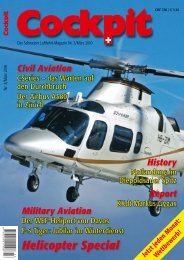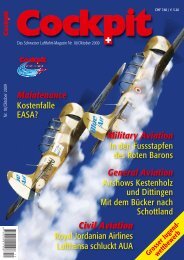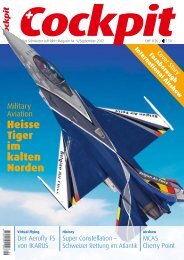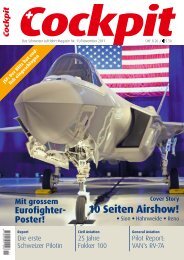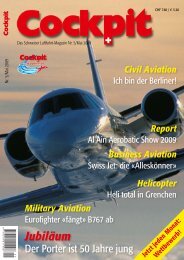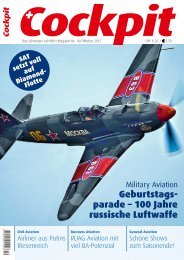Helicopter - Cockpit
Helicopter - Cockpit
Helicopter - Cockpit
Sie wollen auch ein ePaper? Erhöhen Sie die Reichweite Ihrer Titel.
YUMPU macht aus Druck-PDFs automatisch weboptimierte ePaper, die Google liebt.
SHA Inside<br />
36<br />
Swiss <strong>Helicopter</strong><br />
Association<br />
www.sha-swiss.ch<br />
Internationale Kommission für Alpines<br />
Rettungswesen IKAR<br />
Commission Internationale de Secours Alpin CISA<br />
International Commission for Alpine Rescue ICAR<br />
The aim of ICAR is to provide help for those who<br />
are in distress in the mountains or in terrain that is<br />
diffi cult to access.<br />
The ICAR platform was founded in 1948. Within the<br />
ICAR relationship net there are always solutions. It<br />
is an unwritten law and moral responsibility among<br />
mountain rescuers that knowledge and skills and<br />
everything that helps other mountain rescuers are made<br />
available within an adequate amount of time.<br />
ICAR is the worldwide platform for mountain rescue knowhow:<br />
• There are answers to questions.<br />
• There are solutions to problems.<br />
• New methods are demonstrated.<br />
• New equipment and techniques become available.<br />
Mistakes made once are not repeated.<br />
• The impossible becomes possible.<br />
About 300 specialists (rescue specialists in mountainous environment,<br />
rock, snow, ice, emergency physicians, and helicopter<br />
crews) from about 57 mountain rescue organizations<br />
from over 31 countries meet at the annual ICAR congress. The<br />
annual ICAR congress contributes to exchange the experiences<br />
of the past year. Through this process, all reforms and<br />
improvements are disseminated into daily rescue operations<br />
around the world. In 2009, from September 23 to 26 we convened<br />
in Zermatt, Switzerland on invitation from the OCVS-<br />
KWRO (Organisation Cantonale Valaisanne des Secours).<br />
ICAR Air Rescue Commission<br />
There is a huge variety with rescue operations including helicopters<br />
in use (single engine vs. multi engine), topography,<br />
altitude (sea level to 8848 m) as well as signifi cant differences<br />
between our members in terms of crew composition and operational<br />
systems (military crews, government agencies, police<br />
forces, commercial operators, foundations, etc.). These can be<br />
coordinated by either public or private alarm or dispatch centers.<br />
All these factors present a formidable challenge.<br />
Each annual meeting gives us the opportunity to share different<br />
visions, different ways of operating, but also to learn<br />
from past mistakes. In some years, prior to the annual con-<br />
11/2009<br />
gress, a practical day is organized where we share techniques,<br />
we test new helicopters, we demonstrate or experiment with<br />
new rescue equipment.<br />
Zermatt 2009<br />
On the September 22, the ICAR Avalanche and Terrestrial<br />
commissions had their practical day on the Theodul and Plateau<br />
Rosa glacier, while the Medcom had a joint session with<br />
a Hypothermia congress in Zermatt and the Air Rescue commission<br />
was at the Air-Zermatt heliport to test fl y an EC145<br />
especially provided for us by Eurocopter.<br />
All pilots had the opportunity to fl y the EC145 according to<br />
their experience (change certifi cation).<br />
The major subjects discussed this year within the Air Rescue<br />
were : incident – accident, new hoist technology, preliminary<br />
results of helicopter accident analysis done by EHEST, presentation<br />
of the EC175 and Alert Vision by Eurocopter, risk assessment<br />
: the GO decision, an update of the future regulation on<br />
harnesses by the EASA and the impact on the operators and<br />
rescuers and fi nally a total review of all ICAR ARC recommendations.<br />
We also had a joint session with the Medical commission<br />
about the «Recommended Standards for <strong>Helicopter</strong> Emergency<br />
Medical Services (HEMS) in Mountain Rescue». The<br />
results of the working group will be published by the Medcom.<br />
Defi ning standards for others is what I call the biggest challenge<br />
that we face today. It is more and more diffi cult for the<br />
crews to do their job as they are constantly asked to meet new<br />
standards. Some of these requirements do not take into consideration<br />
the point of view of professionals but are strictly<br />
based on the ideas of regulators.<br />
A rescue crew is composed of professionals who know what<br />
they can do and where their limits are. Saving lives is a risky<br />
business but we are aware of the hazards and we are trained<br />
to manage the risk. Taking unnecessary risks is not part of<br />
our standard.<br />
ICAR as the mountain rescue representative worldwide, has<br />
a role to play and will face the challenge.<br />
On Friday, September 24, the OCVS-KWRO rescue team had<br />
organised the complete evacuation of the cabin car running<br />
between Sunegga and Blauherd. The lift was fi lled with ICAR<br />
rescuers and the KWRO-OCVS pilots and mountain rescuer<br />
then did a part of their annual training. Two SA315B (Air-Glaciers<br />
and Air-Zermatt) practiced a very well prepared exercice<br />
and in less than an hour the job was done with not a single incident<br />
to deplore. Precision, professionalism, sling techniques,<br />
radio communication, mountain rescue techniques were shown<br />
by all participants and the result was a very useful exercise.<br />
Next ICAR meeting will be held in Slovakia from October 06<br />
to October 09, 2010.<br />
For more information, go to www.ikar-cisa.org<br />
Patrick Fauchère<br />
President of the ICAR Flight Rescue Commission<br />
Foto: P. Fauchère


